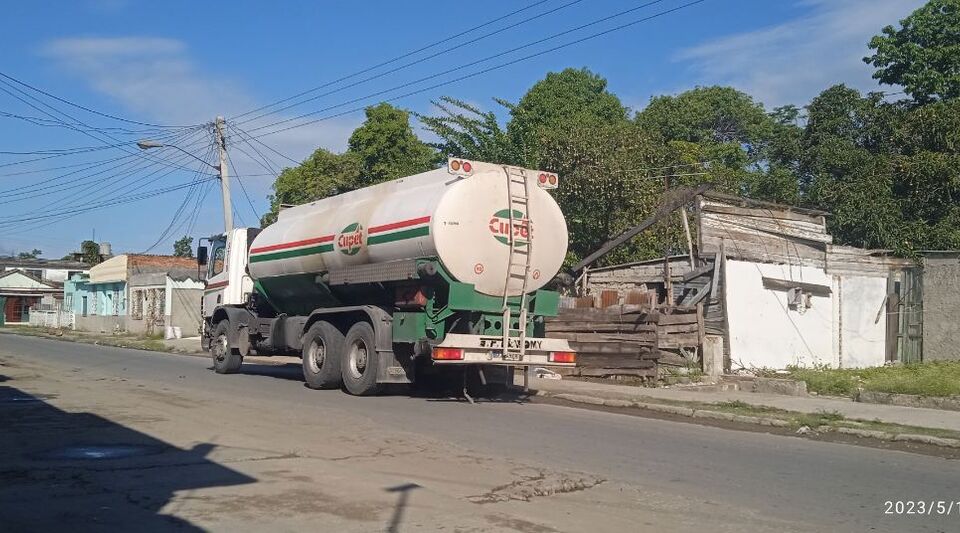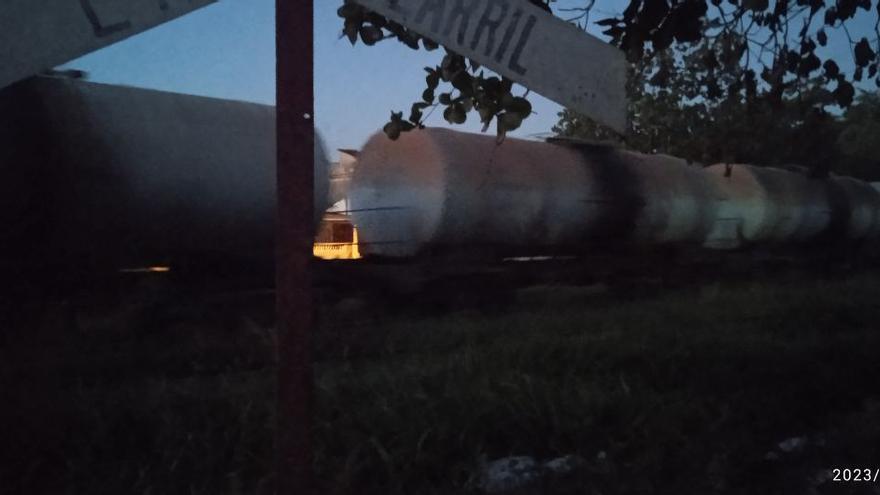Every day, more than ten tanker trucks with the Cuba-Petróleo Union (Cupet) logo leave the Cienfuegos refinery and undertake a long route that takes them to Matanzas, passing through the municipalities of Palmira, Cruces, Lajas, El Diamante, Aguada de Pasajeros and Jagüey Grande. The 195 kilometer journey takes more than three hours. At the end of the road, they await the ruined Supertanker Base – which caught fire in August 2022 and is in the reconstruction phase. with the support of Venezuela– and several oil tankers, whose origin and destination the regime does not report.
We must resort to ship tracking applications, the data revealed by international agencies and, above all, observation on the ground to reconstruct the important oil circuit that connects Cienfuegos with Matanzas: every two hours a Cupet trailer leaves the refinery, loaded with some 25,000 liters of oil derivatives sent by Venezuela, and its trace is lost in the terminals of Matanzas.
However, the path of the trucks and the frantic transfer of oil tankers in Cuban ports continue to demand an explanation. Where is the oil brought from Cienfuegos currently stored, after the partial destruction of the Supertanker Base in 2022? Where is the refined fuel sent in Cuba? Why does the country – which seems to be entering a new stage of blackouts – not benefit from the trade of the nearly two million barrels of oil that arrive each month from Venezuela and, also, from Russia, Mexico or Algeria, in addition to of the heavy crude oil of national production that is used in thermoelectric plants?
The frenetic transfer of oil tankers in Cuban ports continues to demand an explanation
One of the custodians of the Cienfuegos refinery assures 14ymedio that heavy oil is processed in the facilities that ships with the Cuban flag, such as the Wilma and the DelsaThey bring from the Venezuelan port of José. “Then it is sent to the deposits in Matanzas, and stored as a ‘state reserve,’ while between 10 and 20% is linked with Cuban crude, which has a very high sulfur content and high viscosity,” he says. All work is done “under heavy surveillance.”
In addition to the trailers, Cupet uses trains with 14 tank wagons whose destination is also the Matanzas base. Some of the vehicles also divert to Cabaiguán, in Sancti Spíritus, where there is a small refinery, he adds.
This Wednesday, four oil tankers were anchored in the Matanzas Bay and the arrival of a fifth ship was expected. Its about Silt (from Ust-Luga, in Russia), the Marianna VV (from Venezuela), the aquila (with the Panamanian flag and from Santiago de Cuba) and the Primula (with the Belize flag and which stopped at Moa, Holguín), while the tanker Nicos IVflying the flag of Saint Vincent and the Grenadines, will arrive in Matanzas on Thursday, after several weeks without declaring its real position.
The influx of ships in the Matanzas terminal and the efforts of the Cuban government to hide the traffic no longer surprise anyone. At the beginning of May, for example, the oil tanker warm, registered in Malta, docked at the Matanzas Deepwater Dock. After broadcasting images of another ship, Televisión Cubana assured that it would unload 40,000 tons of diesel and affirmed that the authorities had paid 29 million dollars for the fuel, but did not indicate the origin of the product or reveal to whom that money had been paid.
The same strategy is followed with almost all the tankers that call at other ports on the island, particularly Havana, Santiago de Cuba and Mariel, where port activity has multiplied for several months.
Regarding the five oil tankers that operate under the Cuban flag – Wilma, Alicia, Sandino, Delsa and Pastorita–, usually move between the Venezuelan port of José and Jagua Bay, in Cienfuegos, or from one terminal to another on the Island.
The influx of ships in the Matanzas terminal and the efforts of the Cuban government to hide the traffic no longer surprise anyone
Researcher Jorge Piñón, from the University of Texas, USA, informed 14ymedio about the amount of crude that each of these ships transported to the island in May. He Wilma –a ship that disappears from radar as soon as it approaches the Cuban coast– arrived in Cienfuegos on June 1 with 390,000 barrels of crude from José; the same amount charged the Delsaalso from José, to the port of Antilla, on the 30th.
For his part, he Sandino it sailed from José with 440,000 to Nipe Bay, in Holguín, where it arrived on May 5. Meanwhile he Alicia it brought 290,000 barrels to Havana from José on May 16 and another 295,000, coming from another Venezuelan terminal, Amuay, on the 28th.
When comparing these figures with those revealed by the agency Reuters Last week, the total number of barrels of crude oil that arrived on the island during the month of May – some 58,000 per day – coincides, Piñón asserts.
In its usual monthly report on the commercial activities of Petróleos de Venezuela SA, the British agency detected a 14% drop in total exports from that country in May compared to the previous month, but Havana once again escaped the cuts.
In a interview offered to TV Marti, Piñón recalled this Wednesday that Cuba lost a million barrels of storage during the fire in Matanzas and that, given the need to make space to store the 800,000 barrels of high-quality crude that arrived on the island from Russia, it is likely that resold the cargoes of two of the oil tankers from Venezuela. The crude, he explained, was too heavy for the Cienfuegos refinery to process and it took up too much space.
Meanwhile, the repair of the Matanzas Supertanker Base augurs that Cuba is preparing at full speed for an increase in oil traffic. The official press advertisement this Wednesday that the repair of tank 88 is undertaken, which will be ready, he assures, in April 2024. The Oil Maintenance Company (Empet) placed the first steel plates of the tank, which will have an internal floating aluminum membrane and a geodesic dome. It is expected that it can store 50,000 cubic meters of fuel.
In anticipation of fires, they explain, an “automated system” will be built that the Government of Vietnam paid for with a donation of 250,000 dollars. In addition, they plan to place only two tanks in the place previously occupied by the four original tanks, in order to increase the safety distance.
Havana is also betting on the “generosity” of Moscow, which has sent various cargoes of hydrocarbons and is in the process of expanding its business with the island. Russian Prime Minister Mikhail Mishustin, promised this Wednesday to Manuel Marrero “the execution of large joint projects” in the oil field. In the Sochi resort, facing the Black Sea, the Cuban head of government gave his blessing to a new offer from the Kremlin for “increasing oil production in Cuban fields.”
________________________
Collaborate with our work:
The team of 14ymedio He is committed to doing serious journalism that reflects the reality of deep Cuba. Thank you for accompanying us on this long road. We invite you to continue supporting us, but this time becoming a member of our newspaper. Together we can continue transforming journalism in Cuba.








